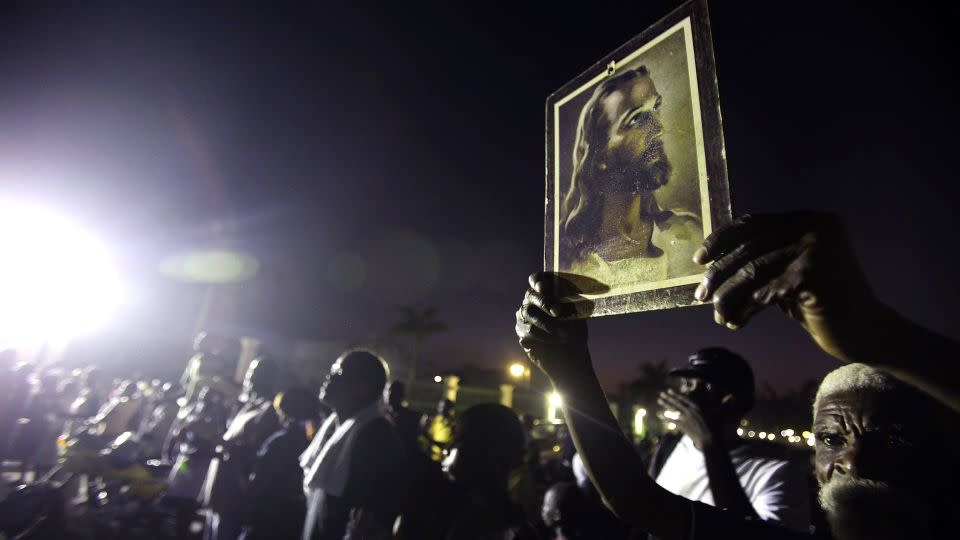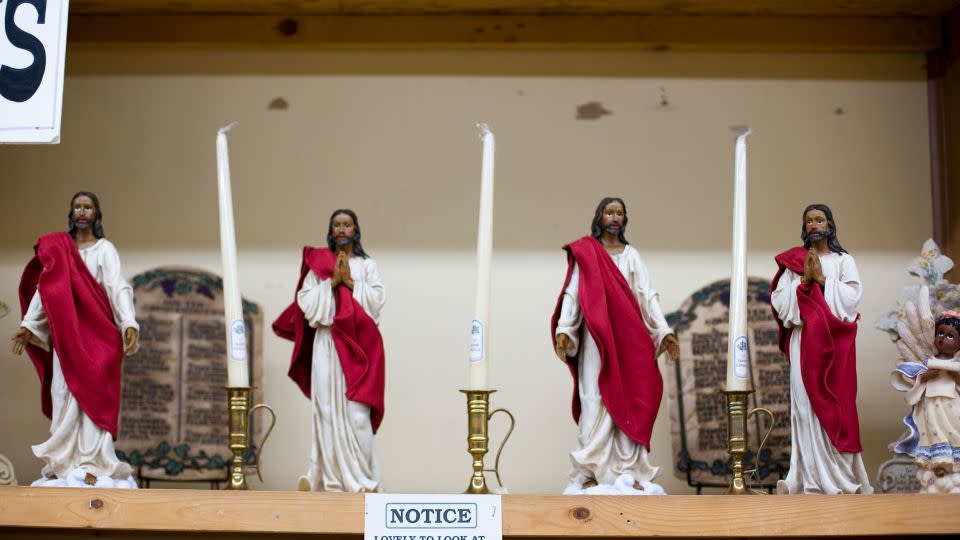Was Jesus a man of color? Why this question matters more than ever
- Oops!Something went wrong.Please try again later.
Christena Cleveland spent much of her childhood in an evangelical church surrounded by traditional images of a porcelain-skinned and flaxen-haired Jesus. But one day she came across a portrayal of Christ that was so astonishing that she gasped.
It was a painting of a resurrected Jesus surrounded by his awe-struck disciples, including “Doubting Thomas” touching the wound in Christ’s torso. The painting looked like an ancient relic discovered in some long-forgotten desert monastery in the Holy Land, a Byzantine-styled fresco filled with sharply contoured figures, bursting with colors of deep blue and blood orange.
But it was another color in the picture that caught her eye. Jesus was depicted as a man of color — somewhere between brown and Black — and so were his disciples. Cleveland, who would go on to become a theologian and social psychologist, realized she had always pictured a Nordic-looking Jesus who looked like Thor. Now she realized that he looked more like her, a Black woman.
For Cleveland, changing the color of Jesus changed how she viewed the meaning of Easter.
“When I see the Easter story, I see Jesus being a victim of state-sanctioned violence. I see Jesus surrounded by Black and brown people who wish they could do something, but had no power in the moment,” says Cleveland, author of “God Is a Black Woman.”
“And I see people being victims of a system that can’t see their full humanity and assumes the worst of them. And yet there’s hope in the end,” she says. “The universe does bend toward justice, even though the arc is long.”
As Christians worldwide celebrate the resurrection of Jesus today, Cleveland’s story points toward an uncomfortable truth: The true face of the historical Jesus looks nothing like the one many still see in their church’s stained-glass windows, in Hollywood movies, or in the image many carry in their minds.
Many scholars and archeologists now agree that Jesus was most likely a brown-skinned, brown-eyed man — more akin to a “Middle Eastern Jewish” or an Arab man. A commentator once said that if Jesus was taking a flight today “he might be profiled for additional security screening” by the TSA.
Some may counter with a big: So what? The debate over the color of Jesus is one of the oldest running arguments in religion. As a man who was raised in a Black church with a giant portrait of a White Jesus hung behind the pulpit, I recall many heated arguments in barbershops and cookouts where armchair theologians insisted that Jesus was Black by citing scriptures like Revelation 1:14-14 (“The Bible said he had hair that was ‘white as wool” and feet like “burnished bronze’ so don’t tell me Jesus didn’t have an Afro!”).
Who can forget when the former Fox News host Megyn Kelly declared in 2013 that Jesus, like Santa Claus, “was a White man, too,” and “that’s a verifiable fact,” a remark she later said was meant in jest.
But the question over the color of Jesus’ skin is a serious one this Easter, for two reasons.
First, while the classic Nordic Jesus remains a popular image today in some churches, a movement to replace the White Jesus has long taken root in America. In many Christian circles — progressive mainline churches, churches of color shaped by “liberation theology,” and among Biblical scholars — conspicuous displays of the White Jesus are considered outdated, and to some, offensive. In a rapidly diversifying multicultural America, more Christians want to see a Jesus that looks like them.
But in some parts of the country, the White Jesus never left. The spread of White Christian nationalism has flooded social media feeds with images of the traditional White Jesus, sometimes adorned with a red MAGA hat. Former President Trump is selling a “God Bless the USA Bible” with passages from the Constitution and Bill of Rights — a linking of patriotism with Christianity that reinforces a White image of Jesus that is central to Christian nationalism.

Second, there’s a new debate about the identity of the historical Jesus. Some critics of the Israel-Hamas war are declaring that Jesus was a “Palestinian Jew,” an assertion that at least one biblical scholar says is false and reprises an ugly historical pattern of “using Jesus against Jews once again.”
Not everyone wants a part of this debate. Some Christians roll their eyes whenever they encounter a question about Jesus’ appearance. They say the Easter story has nothing to do with color and Jesus’ message. They cite scripture like Galatians 3: 28, 29: (“There is neither Jew nor Gentile, neither slave nor free, nor is there male and female, for you are all one in Christ Jesus.”)
There are also those who are religiously neutral and wonder why people have to bring race into everything. As one exasperated commentator said:
“I am so sick and tired of people making a issue out of what color Jesus was or what color were the twelve tribes of Israel or if God is black or white. For me, I personally I DON’T CARE what color any of them were or are. There is no verses in the bible that I know of that make an ‘issue’ out of skin color of people in the bible.”
What’s missing in many of these debates over Jesus’ skin color is a more nuanced perspective from thoughtful people on both sides. Here’s what they say.
Why some say Jesus’ color doesn’t matter
Warner Sallman may be what the New York Times called “the best-known artist of the 20th century,” but he’s not considered one of the masters of his craft. His status rests on one remarkable painting, the “Head of Christ.” It’s been reproduced an estimated 500 million times in portraits that have adorned living rooms, Sunday schools, stamps and prayer cards.
Sallman said the painting was divinely inspired. He was a commercial illustrator who was struggling to sketch a portrait of Jesus for an evangelical magazine one late winter night in 1924. Dejected, he went to bed with no sketch, but said he was awakened at 2 in the morning.
“Suddenly there appeared to my mind’s eye a picture of the Christ just as if it were on my drawing board,” he said.
Sallman’s charcoal sketch, which he later adapted into an oil painting of a light-haired, blue-eyed Jesus with Nordic features (Sallman was the son of Scandinavian immigrants) is a prime example of what critics call the White Jesus. It was released in mid-20th century America during an era of fervent patriotism, record church attendance and hysteria over the perceived threat posed by the Communist Party. Thousands of wallet-sized copies were distributed to American soldiers during World War II.
“It was so iconic that to combat ‘card-carrying members of the Communist Party,’ one American minister wanted every Christian to carry a small print of Sallman’s Christ in their wallets,” wrote Edward J. Blum, co-author of “The Color of Christ.”
That version of America has since changed. But there are some who say Jesus’ color should stay the same, or that it doesn’t matter at all.

Christina L. Barr is a minister and author who has worked in Republican Party politics. She says the Easter message is bigger than any individual color. All people are sinners and Jesus died for them all, regardless of their skin hue, she says.
“Heaven isn’t exclusive for the rich or the fair-skinned,” Barr tells CNN. “God’s arms are outstretched to all.”
Barr says that some people who say they want a Black or brown Jesus may want his melanin but don’t really want his message.
In a column for Black Tea News, the online site where she is the CEO, she imagined if Jesus returned to contemporary America as a Black man. There would be initial excitement among some people until Jesus started preaching about giving up sexual immorality and greed, she said.
“By the time he offends abortion providers by saying God hates hands that shed innocent blood and rebukes Americans for our covetousness, he’d be called a bigoted coon and thoroughly canceled,” she wrote.
Others take a more philosophical approach to the color of Jesus.
“Whether Jesus is depicted in contemporary artwork and icons as white, black, brown, Hispanic or Middle Eastern, it shouldn’t matter, because Jesus’ physicality was merely a vessel which was used to carry something a lot more important — the spirit of his father; God,” Antony Pinol wrote in a column entitled, “Why Jesus’ Skin Color Doesn’t Matter.”
When reached by CNN, Pinol says he is sympathetic to those who say that a darker Jesus is more relatable. He concedes that there are barriers to worshipping a White Jesus that he, a White man, may not understand.
Still, when people become too focused on Jesus’ physical characteristics, they make it more difficult to develop a deeper relationship with God, he says. To him, the color of Jesus doesn’t make a difference.
“It does not fundamentally change what he stands for and the sort of message that’s central to Christianity and what Jesus stood for in his life and actions,” Pino says. “He could be any color and that would not change his message.”
Why others say it does matter
Some, however, argue that the color of Jesus does matter — for a variety of reasons.
Members of various Christian ethnic groups have long since abandoned worshipping a White Jesus. Jesus has been portrayed as Korean, a Black man with dreadlocks, as an indigenous Māori with a full-faced tattoo, and even as a Black woman. It is no longer uncommon to encounter a Black or brown Jesus on stained-glass windows in churches.

Some Black activists have led a movement to discard the White Jesus. Black theologians like the Rev. Albert Cleage have depicted Jesus as a man of color and a revolutionary. And during the George Floyd racial reckoning in 2020, some activists called for statues depicting a White Jesus to be torn down along with Confederate monuments.
Some Black theologians who say Jesus was Black aren’t being literal: They’re making a larger statement against how Jesus has been traditionally portrayed — as a White man at the top of the social hierarchy. The Rev. Dante Stewart reflected this thinking in an essay entitled, “How I Learned that Jesus is Black.”
“I saw why they insisted on saying Jesus is Black,” Stewart, author of “Shoutin’ in the Fire: An American Epistle,” referring to Black theologians like James Cone and author Toni Morrison.
“They were not talking about his skin color during his earthly ministry, though it definitely wasn’t white,” Stewart says. “They were talking about his experience, about how Jesus knows what it means to live in an occupied territory, knows what it means to be from an oppressed people.”
Some also say that Jesus’ color matters because of history.
Blum says the image of a White Jesus has been used to justify slavery, lynching, laws against interracial marriage and hostility toward immigrants deemed not White enough. When Congress passed a law in the early 20th century to restrict immigration from Asia, Southern and Eastern Europe, White politicians evoked the White Jesus, he says.
“One of the arguments was, ‘Well, Jesus was White,’ ‘’ Blum says. “So the theme was, we want America to be profoundly Christian or at least Jesus based, so we should only allow White people in this country.”
The MAGA movement uses the image of a White Jesus to weaponize political battles, he says, pointing to signs at the January 6 insurrection displaying a White Jesus, sometimes wearing a red MAGA hat. To Blum, some Christian conservatives see a White MAGA Jesus as “an anti-woke symbol.”
Another reason that Jesus’ skin color matters is because a person can’t really understand him or his message without taking into account his skin color and socioeconomic status, says Cleveland, the author and scholar.
Cleveland echoes the sentiments of some scholars who say that Jesus was a poor, oppressed minority — a man who one Black theologian described as a “non-White leader of a non-White people struggling for national liberation” from Rome.

In a column for Christianity Today, Cleveland wrote:
“As an ethnic minority, Jesus didn’t simply care about people who were victims of Rome-sanctioned violence, he was a victim of Rome-sanctioned violence. Jesus didn’t simply care about refugees, Jesus was a refugee. Jesus didn’t simply care about the poor, he was poor.”
Cleveland tells CNN that people who say Jesus’ color wasn’t important ignore history.
“It limits our ability to understand the historical Jesus, who wasn’t a White man and didn’t walk through the world as such. He was under Roman occupation — not unlike someone living in Gaza right now. We miss a lot of the historical Jesus’ story and teachings because they were coming from that perspective.”
The Bible holds its own mysteries about Jesus’ appearance
Cleveland discovered, though, how risky it can be to challenge the image of the White Jesus. She says that after she wrote her column, she received so many death threats she had to move the location of the college classes she taught for safety.
She says the experience taught her how much White Christian nationalism and the White Jesus have merged.
“Why would it really matter to you that Jesus wasn’t White — unless you need Jesus to be White?” she says.
The debate over Jesus’ color may seem an intrusion on the Easter story, but in some ways it’s an extension of it. One of the curious elements of the New Testament is that even Jesus’ disciples can’t figure out what he looks like in the Easter stories.

One disciple mistakes him for a gardener, two others walk beside him on a road without recognizing him, and others don’t recognize him at first when they encounter him on a beach.
It’s difficult to imagine what Jesus’ disciples actually saw on Easter morning. The writer Frederick Buechner once tried, memorably describing them as encountering “some new and terrible version” of Jesus, “disfigured by the mutilations of the Cross” while standing up and moving toward them with “unspeakable power.”
Whatever they saw, and what his followers still see, is ultimately a matter of faith. No matter what you believe, Jesus is arguably still the most recognized name and the most elusive figure in human history.
We may try to refashion him in our own image and within our agendas, but he remains — as he did on that Easter morning for his disciples — resistant to any human category we can invent, always beyond our grasp.
John Blake is a Senior Writer at CNN and the author of “More Than I Imagined: What a Black Man Discovered About the White Mother He Never Knew.”
For more CNN news and newsletters create an account at CNN.com

